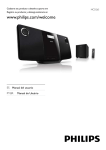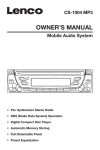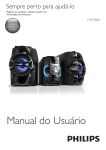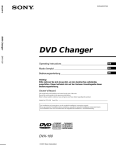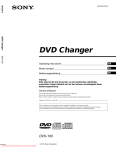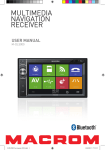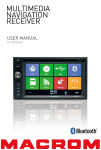Download Caliber MCD263BT Instruction manual
Transcript
CD/MP3 CAR RADIO WITH RDS FUNCTION MCD-263 Instruction Manual DISP EQ AMS < PUSH SEL CAR CD/MP3 PLAYER MCD263 VOL ST R MOD BAND LOUD 1 SCN RPT SHF 2 3 4 REG 5 6 TA AF PTY FM Stereo Radio PLL Synthesizer Tuner RDS (Radio Data System) Function Anti-Shock Mechanism USB Port & SD/MMC Card Slot LCD Digital Display Telephone Mute Function AUX IN & RCA Output Socket Remote Control Full Detachable Front Panel 4 x 70W High Power Output ISO Connectors for Power Supply and Speaker Outputs AUX IN Page CONTENTS 01 Contents 02 Installation 04 Using the detachable front panel 05 Wiring Diagram 06 Operations 06 Location and Function of Keys 07 Using the Remote Control 08 General Operations 10 Radio Operations 11 RDS (Radio Data System) Operations 13 CD/MP3 Disc Operations 14 Mixed-CD Operations 14 AUX in Operations 15 SD/MMC Card Operations 15 USB Device Operations 16 Disc Notes 17 Specifications 18 Trouble Shooting Installation Notes: Take Out Screw Before Installation Before install the unit, please remove the two screws. - Choose the mounting location where the unit will not interfere with the normal driving function of the driver. - Before finally installing the unit, connect the wiring temporarily and make sure it is all connected up properly and the unit and the system work properly. - Use only the parts included with the unit to ensure proper installation. The use of unauthorized parts can cause malfunctions. 1. DIN FRONT-MOUNT (Method A) Installation Opening This unit can be installed in any dashboard having an opening as shown below: 53mm - Consult with your nearest dealer if installation requires the drilling of holes or other modifications of the vehicle. - Install the unit where it does not get in the driver's way and cannot injure the passenger if there is a sudden stop, like an emergency stop. - If installation ang l e exceeds 30°from horizontal, the unit might not give its optimum performance 182mm Installing the unit Be sure you test all connections first, and then follow these steps to install the unit. 1. Make sure the ignition is turned off, and then disconnect the cable from the vehicle battery's negative (-) terminal. 2. Disconnect the wire harness and the antenna. 3. Press the button on the front panel and remove the control panel (For details, refer to 'using the detachable front panel'). - Avoid installing the unit where it would be subject to high temperature, such as from direct sunlight, or from hot air, from the heater, or where it would be subject to dust, dirt or excessive vibration. Din Front/Rear-Mount This unit can be properly installed either from 'Front' (conventional DIN Front-mount) or 'Rear' (DIN Rear-mount installation, utilizing threaded screw Holes at the sides of the unit chassis). For details, refer to the following illustrated installation methods. 4. Lift the top of the outer trim ring then pull it out to remove it. 5. The two supplied keys release tabs inside the unit's sleeve so you can remove it. Insert the keys as far as they will go (with the notches facing up) into the appropriate slots at the middle left and right sides of the unit. Then slide the sleeve off the back of the unit. 6. Mount the sleeve by inserting the sleeve into the opening of the dashboard and bend open the tabs located around the sleeve with a screwdriver. Not all tabs will be able to make contact, so examine which ones will be most effective. Bending open the appropriate tabs behind the dashboard to secure the sleeve in place. 10. Reconnect the cable to the vehicle battery's negative (-) terminal. Then replace the outer trim ring and install the unit's front panel (see the steps of 'to install the front panel'). Removing the unit 1. Make sure the ignition is turned off, and then disconnect the cable from the vehicle battery's negative (-) terminal. 2. Remove the metal strap attached the back of the unit (if attached). 7. Reconnect the wire harness and the antenna and be careful not to pinch any wires or cables. 8. Slide the unit into the sleeve until it locks into place. 9. To further secure the unit, use the supplied metal strap to secure the back of the unit in place. Use the supplied hardware (Hex Nut (M5mm) and Spring Washer) to attach one end of the strap to the mounting bolt on the back of the unit. If necessary, bend the metal strap to fit your vehicle's mounting area. Then use the supplied hardware (Tapping Screw (5x25mm) and Plain Washer) to attach the other end of metal strap to a solid metal part of the vehicle under the dashboard. This strap also helps ensure proper electrical grounding of the unit. Note to install the short threading terminal of the mounting bolt to the back of the unit and the other long threading terminal to the dashboard. 3. Press the release button to remove the front panel. 4. Lift the top of the outer trim ring then pull it out to remove it. 5. Insert both of the supplied keys into the slots at the middle left and right sides of the unit then pull the unit out of the dashboard. 2. DIN REAR-MOUNT (Method B) If your vehicle is a Nissan, Toyota, follow this mounting instruction. Use the screw holes marked T (Toyota), N (Nissan) located on both sides of the unit to fasten the unit to the factory radio mounting brackets supplied with your vehicle. Using The Detachable Front Panel REMOVING THE FRONT PANEL 1 . Press the release front panel . button on the 2 . Pull off the front panel . Fasten the unit to the factory radio mounting brackets. Align the screw holes on the bracket with the screw holes on the unit, and then tighten the screws (5x5mm) on each side. Note: the outer trim ring, sleeve and the metal strap are not used for method B installation. 3 . Store the front panel in the protective case provided for safekeeping . protective case front panel TO ATTACH THE FRONT PANEL To install the front panel, insert the panel into the housing and make sure the panel is properly installed. Otherwise, abnormality occurs on the display or some keys will not function properly. Wiring Diagram White to Front Lch RCA output White to Rear Lch RCA output Antenna Socket L R FUSE ISO CONNECTOR Red to Rear Rch RCA output Red to Front Rch RCA output ORANGE TO TEL.MUTE TO MEMORY B+ GND BPOWER B+ FRONT 4 ohm YELLOW BLACK BLUE WHITE GREY WHITE / BLACK GREY / BLACK LEFT SPEAKER ISO connector: Part A: A1: No Connect A2: No Connect A3: No Connect A4: Battery B+ (Yellow) A5: Antenna (Blue) A6: No Connect A7: Accessory (Red) A8: Ground B- (Black) Part B: B1: Rear Right + (Violet) B2: Rear Right - (Violet/Black) B3: Front Right + ( Grey) B4: Front Right - (Grey/Black) B5: Front Left + (White) B6: Front Left - (White/Black) B7: Rear Left + (Green) B8: Rear Left - (Green/Black) REAR 4 ohm TO ANTENNA RED FRONT 4 ohm RIGHT SPEAKER GREEN VIOLET GREEN / BLACK VIOLET / BLACK REAR 4 ohm Operations Location and function of keys Front panel : 1 10 16 3 < DISP 5 2 PUSH SEL 6 4 CAR CD/MP3 PLAYER MCD263 15 21 EQ 8 VOL AMS ST R MOD BAND LOUD 9 13 1 17 22 SCN RPT SHF 2 3 4 23 24 14 25 REG 5 26 6 TA AF PTY 27 19 18 20 AUX IN 28 The front facet after removing the front panel: 5 7 11 12 Descriptions of Function Controls (1) Power( ) Button (2) LCD display (3) Encoder Volume Control/ SEL Button (4) Release ( ) Button (5) Disc slot (6) Eject ( ) key (7) SD/MMC Memory Card Slot (8) USB Port (9) 7 / MODE(MOD) Button (10) 0 / DISP Button (11) Anti-theft LED Indicator (12) Reset Button (13) Band/ LOUD Button (14) Preset Station (1-6) Buttons (15) AMS(Auto-storage/ Preset memory Scan) ) Button (16) 9 / UP ( Tune up, Seek up, track up, fast forward (17) 8 / DOWN ( ) Button Tune down, Seek down, track down, fast reverse (18) AF/REG Button (19) TA Button (20) PTY Button (21) EQ Button (22) 1 / Playing/Pausing( ) Button (23) 2 / Scan(SCN) Playback Button (24) 3 / Repeat(RPT) Playback Button (25) 4 / Shuffle(SHF) Playback Button (26) 5 / Previous Folder Button (27) 6 / Next Folder Button (28) AUX Input Jack General Operations Switching on/off the unit Switch on the unit by pressing any button (except button and button) or inserting a disc to disc slot. When system is on, press the button to turn off the unit. Sound adjustment - Rotate the volume knob on the head unit to adjust volume level. - Press the SEL button to enter into the audio selecting mode. Press this button continually will change in the following order: VOL BAS TRE (Volume) (Bass) (Treble) BAL FAD (Balance) (Fader) Rotate the volume knob button to adjust the desired sound quality. When TP information gets lost at the current station for retune time, the beep sound is out-putted. When newly tuned station has not RDS signal, “PI SEEK” is suppressed somewhat. PI SOUND/MUTE While AF switching is implemented in C201 station, AF can switch to 100 MHz, which is non genuine AF (where, different PI with same AF) in short “DIP”. If a car cruises that critical area back and forth, an oscillation phenomenon can be occurred, because the different PI code can be received from 100 MHz with “XXX” PI. The car radio has special procedure to reduce even this kind of unavoidable situation however there is a limit to be escaped from this serious case perfectly. In that serious case, 2 modes are selectable as follows: - Press and hold the SEL button for 2 seconds to enter into the menu mode . Press it continually, it is activated as cyclical mode of following functions for user's selection : TA SEEK/ALARM MASK DPI/ALL PI SOUND/MUTE RETUNE L/S BEEP 2’ND/ALL/OFF Rotate the volume knob to select the desired item. TA SEEK/ALARM - TA SEEK mode: When newly tuned station does not receive TP information for a few seconds, the radio retunes to next station which has not the same station (PI) as the last station, but has the TP information. When TP information gets lost at the current station for retune time which is set by RETUNE SHORT (30 sec.) or RETUNE LONG (90 sec.), the radio start to retune to next same PI station. When same PI station does not catch in 1 cyclic search, the radio retunes to next station with TP information. - TA ALARM mode: When this mode is selected, any automatic retune mode is not activated. Only double beep sound (ALARM) is output. When newly tuned station does not have TP information for several seconds, beeps come out. - PI SOUND mode: When above different PI sound (DIP) is heard once in a while, the Dip's sound will be heard for a short time. - PI MUTE mode: Under above same situation, a mute sound will be heard for a short time. RETUNE L/S The initial time of automatic TA search or PI search modes is selected. When PI information is not caught for retune time, the radio starts to retune to next same PI station. When same PI station does not catch 1 cyclic search, the radio goes to last station and waits for several minutes until PI code is received. - RETUNE L mode: Selected as 90 seconds. - RETUNE S mode: Selected as 30 seconds. MASK DPI /ALL The AF frequency (which has different PI or NO RDS signal with high field strength) is masked during checking PI when the unit searches AF. The unit doesn't search this AF (DIP) for few minutes. In the case of the AF of NO RDS signal with high field strength, if the real AF is wrongly masked as DIP by some interference, the unit hesitates to search real AFs. For this reason, the unit has the user option (MASK DPI) which doesn't mask the AF of NO RDS signal with high field strength. In MASK DPI mode, the wrong sound or long mute (according to PI SOUND or PI MUTE) can be heard from the AF station which has NO RDS signal and of which the field strength is higher than that of the currently tuning AF (station). But, these phenomenons are rare and the user will hardly hear the wrong sound in whole Europe. - MASK DPI mode: Mask only the AF which has different PI. - MASK ALL mode: Mask the AF which has different PI and NO RDS signal with high field strength. BEEP 2’ND/ALL/OFF - BEEP 2’ND mode: The beep is only heard when the second function of the dual function button is pressed long (2 sec). e.g. When PRESET button( 1-6 ) is pressed. When BND/LOU button is pressed. When AMS/MP3 button is pressed. When button is pressed. When button is pressed. - BEEP ALL mode: The beep sound is heard when every key is pressed. - BEEP OFF mode: The beep is disabled. Loudness Function Press the BND/LOUD for 2 seconds to reinforce the bass output. Press it for a few seconds again to cancel the function. INFORMATION DISPLAY Press DISP button to operate as the conversion of each display mode as follows: - In case of receiving a RDS station In radio mode: PS ->CT ->FREQ ->PTY In CDP mode:CDP ->CT ->(ID3 TAG) >PS ->FREQ ->PTY * In case of no receiving CT or PTY Information, the display shows as “NO CLOCK” or “NO PTY”. - In case of receiving a non RDS station In radio mode: “NO CLOCK” ->FREQ>”NO PTY” In CD mode:CD -> NO CLOCK -> FREQ > “NO PTY” Each displaying time is several seconds, and come back to 1'st position after several seconds. Notes: CT = clock time FREQ = frequency. Equalization Press the EQ button to turn on the equalization function and to select desired audio mode. There are four kinds of mode as below: To select playback mode In power on mode, press MODE button repeatedly to select the different modes as the following sequence: RADIO, DISC (with a CD/MP3/WMA disc inside the disc slot) , USB(with a USB device inside the USB port), SD card(with a card inside the card slot) or AUX mode. LCD DISPLAY Exhibit current frequency and activated functions on the LCD display. FLASHING LED The led display will flash if the front panel is not inserted into the main unit. ESP FUNCTION This unit has the electronic shockproof feature. So that if the unit skips due to rough road conditions, the playback of the disc / USB / SD will be uninterrupted. TEL Mute The audio system automatically mutes whenever a call comes in. Note: the function will not work if a cable is not connected to the car phone. 1. When a call comes in When a call is received, 'TEL CALL' is displayed and all the unit functions are temporarily interrupted. 2. When the call ends Hang up the phone. 'TEL CALL' disappears from the display. The original source (i.e. the one used before the phone call) is returned to automatically and the volume restored gradually. Reset function RESET button must be activated with either a ballpoint pen or thin metal object. The RESET button is to be activated for the following reasons: - Initial installation of the unit when all wiring is completed. - All the function buttons do not operate. - Error symbol on the display. Note: if you press RESET button, the unit can't work yet, please use a cotton swab soaked in isopropyl alcohol to clean the socket on the front panel. Radio Operations SWITCHING TO RADIO MODE Press MODE button to select radio mode, the radio mode appears on the LCD display together with the memory band and frequency. SELECTING THE FREQUENCY BAND Press BND button to select the desired band. The reception band will change between FM1 , FM2 , FM3. SELECTING STATION - Press preset 1-6 button to select a station which had been stored in the memory. - Press the button for 2 seconds until “MANUAL” appears on the display, and then press the button to select a station. If both buttons have not been pressed for several seconds, they will return to automatic seek mode . AUTOMATIC MEMORY STORING & PROGRAM SCANNING - Automatic memory storing Press the AS/PS button for 2 seconds, the radio searches from the current frequency and checks the signal strength until one cycle search is finished. And then 6 strongest stations are stored into the corresponding preset number button. - Program scanning Press the AS/PS button shortly to scan preset station. When the field strength level is more than the threshold level of stop level, the radio is holding at that preset number for several seconds with release mute, and then searches again. STATION STORING - Press the button to activate automatic seek mode. - In manual mode, press the button to select a station. Press the preset 1-6 button for 2 seconds to store current station into the number button. RDS (Radio Data System) Operations Setting RDS mode Press the AF/REG button and release immediately to switch on or off RDS mode. Whenever RDS is switch on, symbol “ AF ” appears on the display. Program name is displayed on receiving a RDS station. “ AF ” starts blinking if the broadcasting signals getting worse. “ ALARM ” will be displayed when an emergency broadcasting is received; meanwhile sound output level will be adjusted to the preset output level automatically when the volume control is set at minimum. Regional Program Operation Press the AF/REG button for 2 seconds to switch on or off region mode. Some broadcasting stations change their program from normal broadcasting to regional broadcasting for a certain time period. When region is on, the current listening program remains unchanged. When region is off, it allows the reception moves to the regional station. Using PTY to Select Program Press the PTY button repeatedly to select the PTY as follows: PTY MUSIC GROUP PTY SPEECH GROUP GROUP PTY OFF When the PTY MUSCI GROUP or PTY SPEECH GROUP has been selected, press any one of the preset numbered buttons repeatedly to search relevant PTY information. And stop searching if the radio detect the PTY relevant information. If the relevant PTY information is not found, the radio exit the PTY engagement and return to previous normal mode. HINT: When you the select PTY MUSIC GROUP, the preset numbered buttons is shared as follows: M1. POP M, ROCK M M2. EASY M, LIGHT M M3. CLASSICS, OTHER M M4. JAZZ, COUNTRY M5. NATION M, OLDIES M6. FOLK M When you select the PTY SPEECH GROUP, the preset numbered buttons is shared as follows: M1. NEWS, AFFAIRS, INFO M2. SPORT, EDUCATE, DRAMA M3. CULTURE, SCIENCE, VARIED M4. WEATHER, FINANCE, CHILDREN M5. SOCIAL, RELIGION, PHONE IN M6. TRAVEL, LEISURE, DOCUMENT Listening to Traffic Announcement TA button is operated as follows: When pressed and hold for several seconds, it is engaging whether TA mode on or off. When TA mode is on and a traffic announcement is transmitted: When the unit was in CD (MP3/WMA), USB/SD/MMC or AUX IN mode, it will switch temporarily to radio mode. Temporary switch over to an EON linked station when EON detects a traffic announcement on that other program. If the volume level was under the threshold point it will be raised to the threshold point. But the user changed the volume level, which was more than the threshold point (min. TA volume level), it will be set to the last level. When TA mode is on, TA of individual segment is turned on. When a TP station is received, TP of individual segment is turned on. TA interruption function The current traffic announcement is cancelled by pressing this key. But the TA mode will not be off. When pressed long, it is selected EON TA LOCAL/EON TA DISTANCE mode. The purpose of this key is to reduce unwanted EON TA switching. Which EON TA information was received from current station and the radio switched to that EON linked station, but information could not be received because the EON linked station is located too far from that area. So the radio is switched back to current station again. In above operation, a customer listens to a wrong program or mute sound for a while. radio is switched back to current station again. In above operation, a customer listens to a wrong program or mute sound for a while. EON TA LOCAL mode When the filed strength level of EON linked is less than threshold level, the radio does not switch that station, and a customer can hardly listen to any disturbances. When EON TA LOCAL mode is selected, “EON TA LO” on numeric display is indicated for a few seconds. EON TA DISTANCE mode EON TA switches is tried to implement by the information of current station. When EON TA DISTANCE mode is selected, “EON TA DX” on numeric display is indicated for a few seconds. The RDS digital data includes the following: PI PS Program Identification Code for identifying programs Program Service Name Broadcast station name data expressed in alphanumerically characters. Alternative Frequencies AF Frequency list of broadcasting stations transmit the same program. TP Traffic Program Identification data for traffic information-broadcasting station Traffic Announcement Identification data showing traffic TA information is being transmitted or not Enhanced Other Networks Broadcasting information on PI,AF, EON TP,TA, etc, relating to networks other than the network used for current reception Program Type Code PTY Contents of programs such as news, light music, sports etc. CD/MP3 Disc Operations Switching to CD/MP3 mode 1. If there is no CD/MP3 disc inserted in the player: Gently insert a CD/MP3 disc with the printed side facing up into the disc slot until you feel some resistance. The disc is draw into the driver automatically. The CD/MP3 playback begins. 2. If a CD/MP3 disc is already inserted in the player, press MODE button to switch to the CD/MP3 mode. Loading/Removing the disc Insert the disc into the disc slot with the printed side facing up , the player will play the disc automatically. Whenever press the button to eject the disc. Selecting tracks in single step - Press the or to skip to the previous track or the following track. The track number shows on the LCD. - Press and hold the or button to fast reverse or fast forward. To resume normal playback you release the button. Pause playback Press the button to pause CD/ MP3 playing. Press it again to resume playback. Previewing all tracks Press the SCAN button to play first several seconds of each track on the current disc. Press it again to stop intro scan and listen to track. Repeating the same track Press the RPT button to set the unit to repeat the same track. Press it again to stop the repeat function. Playing all tracks in random Press the SHF button to play all tracks on CD/MP3 disc in random order. Press again to cancel this function. Selecting directory up/down During MP3 playback, press the M5 or M6 button to select directory downward or upward. If the MP3 disc does not contain any directory, there is no function by using the M5 or M6 button. Searching file and directory Press the AS/PS or AMS/MP3 repeatedly to cycle through the following search mode: Searching by track number Searching by directory or file name Searching from root directory Searching from current directory Searching by track number Press the AMS button once to enter ' Searching by track number ' mode. The track number will blink on the LCD display. 1). Rotate the volume knob to select the track number. 2). Press the BAND button to confirm and play the selected song. Searching by directory or file name 1). Press the AMS button twice to enter ' Searching directory or file name ' mode. 2). In this search mode , you can press the corresponding buttons listed on the Table 1 below : Key M1 M2 M3 M4 M5 M6 Character Key Character S,T,U,7 A,B,C,1 MODE V,W,X,8 D,E,F,2 G,H,I,3 or MUT Y,Z,space,9 _,-,+,0 J,K,L,4 DISP or M,N,O,5 A-Z,0-9,_, Rotate VOL -,+ P,Q,R,6 3). Press the SEL button to confirm entry of each characters. 4). Press the BAND button to search the title. If inputted directory or file name does not exist, “NO FOUND” is show on LCD display. 5). If the selected title is a directory name, LCD will be shown “D-DIR”. Rotate the volume knob, you can list all songs under this directory and select the title. 6). Press the BAND button to confirm and start playback. * If the selected title is a directory, repeat the above steps. Searching from root directory Press the AMS button thrice to enter ' Searching from root director ' mode. 1). Rotate the volume knob to browse file or directory in root directory. 2). Press the BAND button to confirm. To start playback if the selected title is a file. If the selected title is a directory, LCD will shown “ D-DIR ”. Rotate the volume knob to list all files, then press the BAND button to play the selected file. * Repeat above steps if the selected title is a directory again . Searching from current directory Press the AMS button for four times to enter “ Searching from current directory ” mode. 1).Rotate the volume knob to browse file or directory in current directory. 2). Press the BAND button to confirm. To start playback if the selected title is a file. If the selected title is a directory, LCD will shown “D-DIR”. Rotate the volume knob to list all files, then press the BAND button to play the selected file. * Repeat above steps if the selected title is a directory again. Supported MP3 decoding modes The main unit supports MP3 decoding modes as below : Mixed-CD Operations If available, the unit can play the mixedCD disc (the disc contains both CD audio tracks and MP3 files). When you insert a mixed-CD disc into the CD slot, it starts to play the CD audio tracks. And the operation is the same with the CD operation described as above. If you want to play MP3 files, press M5 button or M6 button, it will searching the disc over and start to play the MP3 files. And the operation is the same with the MP3 / WMA operation described as above. If you want to return to CD mode, press M5 button or M6 button, it will search the disc over and start to play the CD audio track. And the operation is the same with the CD operation described as above. In this way, you can switch between playing CD audio tracks or MP3 songs repeatedly. Bit rate ( kbps ) 32,48,64,96, 128,192,256, 320 Aux In Operations CAUTION When there are important files in the CD/CD-R (W) disc, do not connect it to the main unit to play. Because any wrong operation may cause files loss. And we won't answer for the direct or indirect damage caused by losing files. This player has a auxiliary input jack. it is compatible with the audio output from an MP3 music players. If you have plugged such a player into the AUX IN jack, press the MODE button to switch the input source to AUX . SD/MMC Card Operations This unit equipped with a memory card slot. Using the SD/MMC card: When you insert a SD/MMC card into the memory card slot, the player will reading the SD/MMC card automatically. The unit gives first priority to the latter. If insert a disc into the disc slot while read the SD/MMC card, the unit will playing the disc. You can presses MODE button to select SD/MMC mode. SD/MMC memory card playing operation is the same with the MP3 operation described above. Note: - The operations of the MP3 file in the SD/MMC memory card is the same as the operations of MP3 disc. - When reading the memory card, be sure not to touch or remove the memory card from the SD/MMC card slot. - If following the instruction above, the unit can't read the card, please check if the card is in good condition, or take out the card then insert it into the card slot once more. USB Device Operations The unit is equipped with a USB port on the front panel of the unit, you can connect a USB stick through the USB port. Using the USB stick: When you insert a USB stick through the port, the unit will search the MP3 files and start to play it automatically. The unit gives priority to the latter. If insert a disc into the disc slot while read the SD/MMC card, the unit will playing the disc. You can presses MODE button to select USB mode. Note: - Use the USB adaptor cable, if necessary. - The operations of playing the MP3 file in the USB is the same as the operations of MP3/WMA disc. - When reading the USB device, be sure not to touch or remove it from the USB port. - If following the instruction above, the unit can't read the file in the USB device, please check if the device is in good condition, or take it out then insert it into the USB port once more. - This car CD/MP3 player can only support the standard USB-memory device. - USB MP3 player is not a standard which means different brand name or different models have their own standard. So this product cannot support all MP3 players. - When connecting an MP3 player and there is a normal battery in the player (non rechargeable battery), you should remove the battery from the MP3 player then connect it to the USB port. Otherwise, it may cause battery burst. Disc Notes A. Notes on discs: 1. Attempting to use non-standard shape discs (e.g. square, start, and heart) may damage the unit. Be sure to use round shape CD discs only for this unit. 2. Do not stick paper or tape, etc, onto the label side or the recording side of any discs, as it may cause a malfunction. Dirt, dust, scratches and warping discs will cause disoperation. B. Notes on CD-Rs (recordable CDs)/CDRWs (rewritable Cds): 1. Be sure to use discs with following marks only for the unit to play: 2. The unit cannot play a CD-R and CD-RW that is not finalized. (Please refer to the manual of your CD-R/CD-RW recorder or CD-R/CD-RW software for more information on finalization process). 3. Depending on the recording status, conditions of the disc and the equipment used for the recording, some CD-Rs/CDRWs may not be played on this unit. (see *1) *1: To have more reliable play back, please see following recommendations: a. Use CD-RWs with speed 1x to 4x and write with speed 1x to 2x. b. Use CD-Rs with speed 1x to 8x and write with speed 1x to 2x. c. Do not play a CD-RW which has been written for more than 5 times. C. Notes on MP3 files The disc must be in the ISO9660 level 1 or level 2 format, or Joliet or Romeo in the expansion format. 1. When naming a MP3 file, be sure the file name extension is 'Mp3'. 2. For a non-MP3 file, even though the file name extension is 'MP3', the unit cannot recognize it. D. Handling and Cleaning - Dirt, dust, scratches and warping discs will cause disoperation. - Do not place stickers or make scratches on discs. - Do not warp discs. - A disc should always be kept in its case when not in use to prevent from damage. - Do not place discs in the following Places: 1. Direct sunlight. 2. Dirty, dusty and damp areas. 3. Near car heaters. 4. On the seats or dashboard. Disc Cleaning Use a dry soft cloth to wipe the surface. If the disc is quite dirty, Use a soft cloth slightly moistures with isopropyl (rubbing) alcohol. Never use solvents such as benzene, thinner or conventional record cleaners as they may mar the surface of the disc. Note: A disc may become somewhat scratched (although not enough to make it unusable) depending on the way it is handled and conditions in the usage environment. Note these scratches are not an indication of any problem with the player. E . Preparing New Discs with Rough Spots A new disc may have rough edges on its inside and outside edges. If a disc with rough edges is used, the proper setting will not be performed and the player will not play the disc. Therefore, remove the rough edges in advance by using a ballpoint pen or pencil as shown on the right. To remove the rough edges, press the side of the pen or pencil against the inside and outside edges of the disc. Specifications 1. GENERAL Power Supply Requirements DC 12 Volts, Negative Ground Chassis Dimensions 178(W)x160(D)x 50(H) mm Tone Controls - Bass (at 100 Hz) ±10 dB - Treble (at 10 KHz) ±10 dB Maximum Output Power 4x70 watts Current Drain 15 Ampere (max.) 2. CD PLAYER Signal to Noise Ratio > 55 dB Channel Separation > 40 dB Frequency Response 40Hz - 18 KHz 3. RADIO FM Frequency Coverage 87.5 - 108 MHz IF 10.7 MHz Sensitivity (S/N=30dB) 4µV Stereo Separation >25dB Trouble Shooting The following chart will help in solving most problems that may occur. If you still have questions after going through the checklist, please consult your local customer service representative. Before going through this check list, refer the wiring and operating procedures. Symptom Cause The car ignition switch have not turn on. If the power supply is connected to the car accessory circuits, but the engine is not moving, switch the ignition key to “ACC”. The fuse has been blown. Replace a new one. Presence of CD disc inside the player. Remove the disc from the player, and insert a new one. Inserting the disc in reverse direction. Insert the CD with the label facing upward. The surface of CD is extremely dirty or has been scraped. Clean the disc or try to replace a new one. Temperature inside the car is too high. Cool off or until the ambient temperature return to normal. Condensation Leave the player off for an hour or so, and then try again. Volume is in minimum . Adjust volume to a desired level . The wiring is not properly connected . Check wiring connection . The installation angle is more than 30 0. Adjust the installation angle less than 30 0. The surface of CD is extremely dirty or has been scraped. Clean the disc or try to replace a new one. 1. The built-in microcomputer is not operating properly due to noise. 1. Press the RESET button to restore the program. 2. The front panel has not properly installed. 2. Fixed the front panel into its place. The antenna cable is not connected. Insert the antenna cable firmly into the antenna socket of this CD player. No power Disc can not be loaded or ejected. No sound Sound skips The operation keys do not work No radio reception. Solution In automatic search mode The transmission signals are the radio does not stop at too weak. a transmitting station. Select a radio station manually.



















